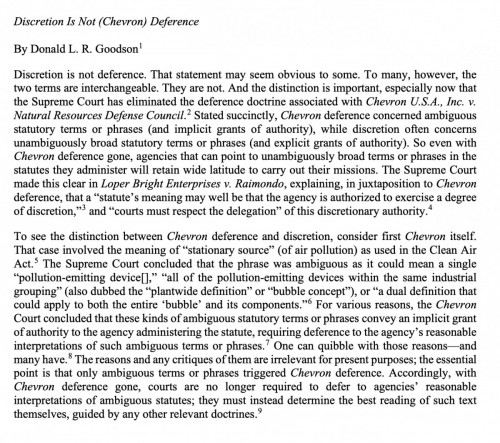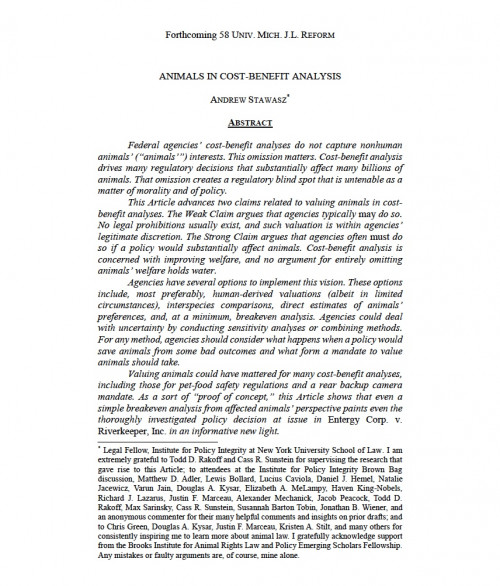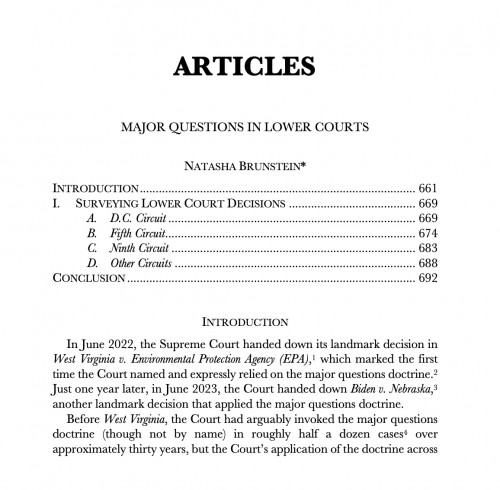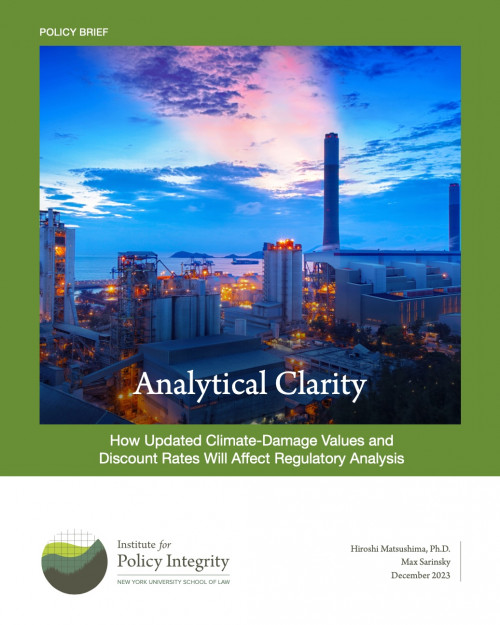-

Discretion Is Not (Chevron) Deference
Published in the Harvard Journal on Legislation
Discretion is not deference. That statement may seem obvious to some. To many, however, the two terms are interchangeable. They are not. And the distinction is important, especially now that the Supreme Court has eliminated the deference doctrine associated with Chevron U.S.A., Inc. v. Natural Resources Defense Council. Stated succinctly, deference concerned ambiguous statutory terms or phrases (and implicit grants of authority), while discretion often concerns unambiguously broad statutory terms or phrases (and explicit grants of authority). So even with deference gone, agencies that can point to unambiguously broad terms or phrases in the statutes they administer will retain wide latitude to carry out their missions.
-
Major Rules in the Courts
An Empirical Study of Challenges to Federal Agencies’ Major Rules
This working paper summarizes the first empirical study of how major rules, as defined under the Congressional Review Act (CRA), fare in federal court. The study covers each of the 1,870 major rules issued from the CRA’s enactment in 1996 through the end of the Trump Administration. The roughly 24-year period covering four administrations (two from each party) is the longest continuous timespan of any empirical study of agency win rates.
-

Animals in Cost-Benefit Analysis
Forthcoming in the University of Michigan Journal of Law Reform
Federal agencies’ cost-benefit analyses do not capture nonhuman animals’ interests. This omission matters. Cost-benefit analysis drives many regulatory decisions that substantially affect many billions of animals. That omission creates a regulatory blind spot that is untenable as a matter of morality and of policy. Valuing animals could have mattered for many cost-benefit analyses, including those for pet-food safety regulations and a rear backup camera mandate. As a sort of “proof of concept,” this Article shows that even a simple breakeven analysis from affected animals’ perspective paints even the thoroughly investigated policy decision at issue in Entergy Corp. v. Riverkeeper, Inc. in an informative new light.
-

Major Questions in Lower Courts
Published in the Administrative Law Review
In June 2022, the Supreme Court handed down its landmark decision in West Virginia v. Environmental Protection Agency (EPA), which marked the first time the Court named and expressly relied on the major questions doctrine. This Article surveys how lower federal courts have interpreted West Virginia and applied the major questions doctrine. There is no one major questions doctrine in the lower courts. Judges have taken vastly different approaches to defining and applying the doctrine both within and across circuits. These differences illustrate that many judges may view the doctrine as a little more than a grab bag of factors, which they seem to be choosing from at their discretion. Lower court judges do not appear to be constrained in how they apply the doctrine. In a majority of cases concerning Biden Administration agency actions and executive orders, judges applied the doctrine to reach outcomes that aligned with the political party of their appointing President.
-
Supplemental Comments to NHTSA on Proposed Vehicle Fuel-Economy Rule
In August, the National Highway Traffic Safety Administration (NHTSA) proposed to strengthen vehicle fuel-economy standards. Since then, the Environmental Protection Agency has finalized its update to the social cost of greenhouse gases and the Office of Management and Budget has finalized its revisions to Circular A-4. In light of these updates, we submitted a supplemental comment letter reasserting our call for NHTSA to assess regulatory impacts using the best available economics.
-
Supplemental Comments to CEQ on Climate Change Guidance
Earlier this year, the Council of Environmental Quality (CEQ) published interim guidance on analyzing climate change effects under the National Environmental Policy Act in which it endorsed using the social cost of carbon in environmental analysis. In this supplemental comment letter, we suggest that CEQ specifically endorse the Environmental Protection Agency’s newly-updated climate-damage values when it finalizes the interim guidance.
-
Policy Integrity Scholarship and Advocacy Shapes EPA’s New Climate Damage Valuations
On December 2nd, EPA released a new methane regulation that includes final updated values for the social cost of greenhouse gas metrics. The updated metrics align with many of the recommendations Policy Integrity made in our comments on the draft values, and our scholarship and analysis were cited heavily in the associated federal documentation.
-

Analytical Clarity
How Updated Climate-Damage Values and Discount Rates Will Affect Regulatory Analysis
Recently completed and draft guidance is ushering in updated practices for federal benefit-cost analysis. This policy brief examines the impact of two of the most significant upcoming changes: to the discount rate and the social cost of greenhouse gases.
-
Policy Integrity Work Shapes Long-Overdue Updates to Federal Regulatory Guidance
On November 9th, the White House finalized its revision of Circular A-4, the primary guidance on how federal agencies should assess the costs and benefits of regulations. This document plays a critical role in federal policymaking, and it had not been updated in two decades. The new guidance represents a major improvement over current practice and incorporates numerous changes that Policy Integrity has long recommended.
-
Comments to OMB on Draft Update of Circular A-4
This spring, the Office of Management and Budget (OMB) proposed a comprehensive update to the federal guidance document on best practices for conducting benefit-cost analysis, known as Circular A-4. Jointly with thirteen other nonprofit groups, we submitted comments commending particular aspects of the update and offering suggestions for further improvement.
Viewing recent projects in Regulatory Process




